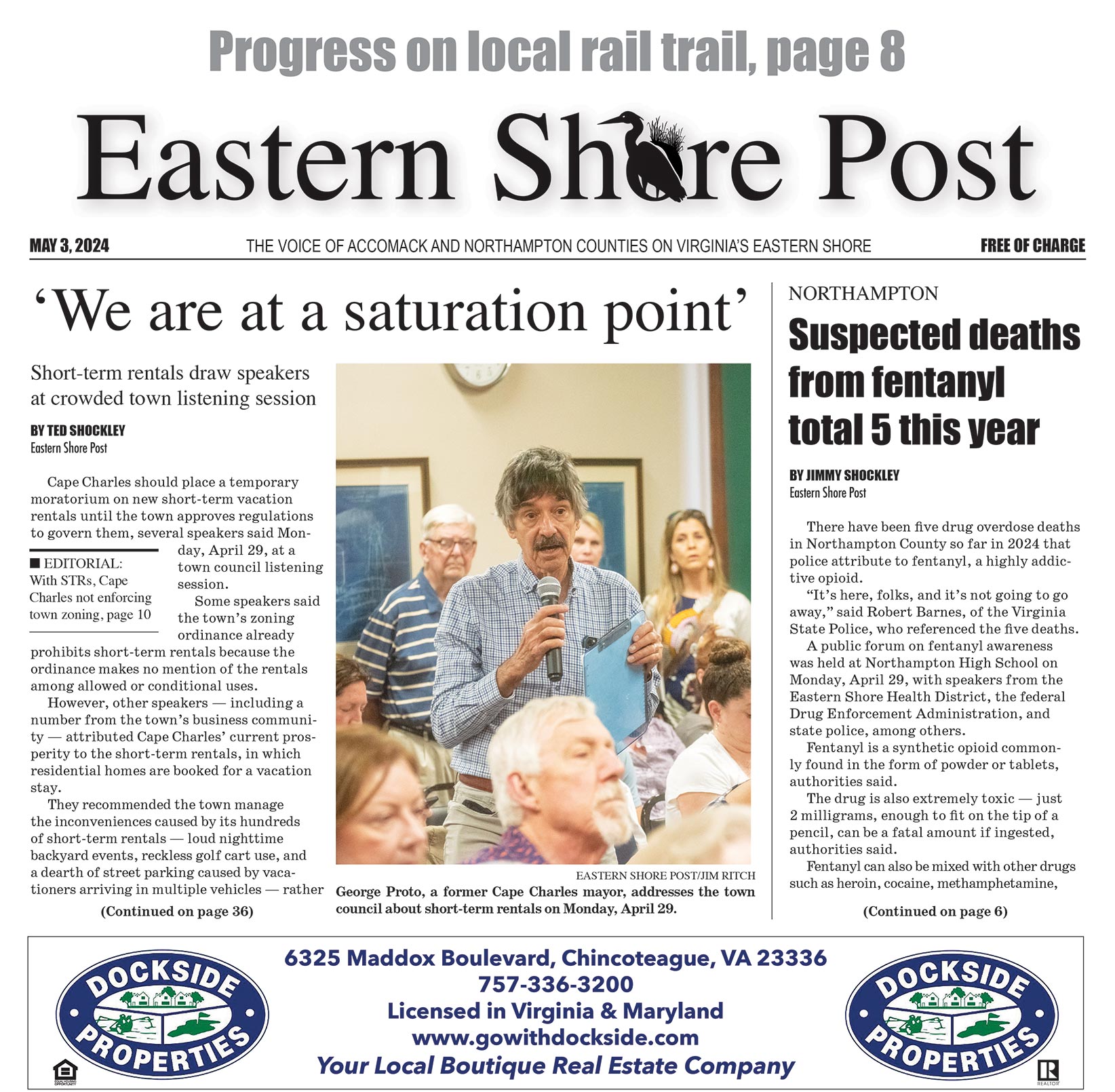
BY KIRK MARINER, Special to Shore First
At “the Hermitage” near Cape Charles, the noises and dangers of the modern world seem far removed.
The old house, built prior to 1783, stands at the end of its own private lane half a mile east of Cape Charles, a handsome structure with a gambrel roof and dormer windows. The front yard is studded with shade trees and lined by a white wooden fence, while at the back the house commands a lovely view of Kings Creek. To the many visitors who have trooped around and through it during Garden Week, the Hermitage conjures up enviable visions of the quiet country life.
But the modern world once intruded upon this pleasant spot with a horror such as the world had then seldom seen. It was here that, for one of the first times in the world, a man was murdered by the very modern means of a bomb sent through the mail.
In 1936 the Hermitage was owned by Curry S. Thomas, 47 years old, well-to-do gentleman farmer. His first wife died in 1934 when her car was struck by the train at the crossing nearest the house, and he was a widower when he met Elsie Dickinson Salmons, who first came to Cape Charles to visit her brother, attorney W.A. Dickinson. Mrs. Salmons was by then divorced, and had for three years been employed as an assistant to Harvey R. Hege, a dentist in Mount Airy, North Carolina. After several visits back and forth, Curry and Elsie were married on June 10, 1936, at her mother’s home in her native Hillsville, Virginia, and the newlyweds promptly took up residence in the Hermitage.
On July 22, the 41st day of their marriage, the Thomases stopped by the post office at Cape Charles on their way home from a golf game at the local country club. Waiting for them there was a small package wrapped in brown paper, tied with ordinary string, and bearing a Richmond return address.
“A wedding present!” exclaimed some friends who happened to be in the post office at the time, and they urged the couple to open it right then and there. But the Thomases resisted, and hurried home. After pulling his sedan to a stop at the Hermitage, Curry Thomas took the package into his lap and broke the string around it.
The explosion that followed could be heard for a mile, and sent parts of the automobile hurtling 100 yards across the property. Elsie Thomas was blown out of the car with shrapnel in her left side and arm, and with injury to one eye. Curry Thomas was killed instantly.
The explosion occurred about 6:30 p.m. on Wednesday. By the end of the day S. Thomas Nottingham, postmaster and former police chief at Cape Charles, had notified Federal authorities of the bombing, and the scene of the crime had been roped off to protect it from the curious. By noon Thursday investigators from the postal service, flown in by Navy plane from Baltimore, were taking charge of the case. Among them were 6-foot, 250-pound B.B. Webb and “a little fellow with a black moustache” named J.B. Sentman; together the two were said to resemble the comic strip characters Mutt and Jeff. By Friday some of the inspectors had been dispatched to Mount Airy and Hillsville, and to Galax, Virginia, where Mrs. Thomas’ first husband lived. Curry Thomas was buried on Friday. His widow, meanwhile, lay in the Nassawadox hospital in serious condition, often delirious.
For weeks the investigation moved too slowly for a community frightened and incensed by so horrible and senseless a crime. After four days in the Western Shore towns, the investigators moved on, veiling their work in secrecy and promising a public statement only when an arrest was made. By September, Eastern Shore citizens were growing impatient. “Why have we any reason to believe that we are being protected against this criminal or others of his like?” demanded the Northampton Times of Cape Charles. The county sheriff, his deputies, and the Cape Charles police all stood ready and eager to take up the case, but had been told by the Federal officials that “We’ll handle it.” “But what about results?” stormed the Times.
It took less than three months for the investigators to get their man. At 10:00 p.m. on Monday, October 6, two men from North Carolina walked into the Bluemont Hotel in Galax, unaware that the people in the lobby included three postal investigators (including Mutt and Jeff), an array of local police and state troopers, and, from Northampton County, sheriff George T. Turner and Commonwealth’s Attorney C.M. Lankford. Sheriff Turner presented them with warrants, arrested and handcuffed them, and promptly left for Eastville with his culprits. Charged with the crime were Elsie’s old employer Dr. Hege and his friend and “alibi” Edward Banner.
The investigators had done a thorough job of connecting the bombing to Hege. Through remnants at the scene of the crime they had learned that the bomb had been built from a mousetrap, a small battery, a fuse, and dynamite in a piece of pipe. They traced the battery to its factory of origin in Canada, then to Mount Airy, the typewritten return address to Chicago, then back to the dentist, and even the string that bound the package to Hege’s supply house. There were witnesses from Richmond who placed Hege and Banner there the day the bomb was mailed. As for motive, there were letters from Hege who strongly objected to Elsie’s leaving his employ to get married, and Elsie’s statement that Hege, though a married man with children, had become infatuated with her to such an extent that she had considered giving up her job — though later, upon meeting Curry Thomas, he had expressed a high regard for him, and wished them both well.
In Eastville, Hege and Banner were lodged in separate cells in the county jail and the considerable evidence against them placed in the hands of Lankford. Within hours, Deputy John R. Womble found Hege in his cell bleeding from the wrists. When Dr. Holland Trower was summoned to stitch up the wound, Hege insisted he must have broken the crystal of his watch as he rolled over on it while sleeping. During the next several days Hege engaged a local attorney, summoned another from Mount Airy, asked his wife to visit him, and steadfastly maintained his innocence. “I may have been indiscreet,” he told his attorney, “but as God is my witness I had nothing to do with that bomb.” On Saturday night, October 10, he complained of headaches and asked that his eyeglasses be returned to him. The following morning he was found dead in his cell, the eyeglasses broken and the glass used to slit his wrists and throat.
Dr. Harvey Hege was buried in Mount Airy on October 14. Elsie Thomas left the Nassawadox hospital on October 20. Before the end of the month Edward Banner had been cleared of conspiracy in the murder, and charges against him dropped. On November 8, Federal authorities announced the closing of the case.
The Cape Charles mail bombing, picked up by the Associated Press and United Press International, was news from coast to coast. It was covered in detail by the Richmond Times-Dispatch, and was frontpage news in the Washington Post and the Los Angeles Evening Herald & Express. Five years later it was featured in True Detective magazine, complete with a photograph of Thomas’ bombed sedan.
Elsie Thomas fully recovered from the bombing incident, and later remarried and moved to Amarillo, Texas. She died in 1981, and is buried there.
Dr. Hege’s house in Mount Airy, built about 1925, was at one time listed in the National Register of Historic Places. It was demolished in 1992 to make room for the future expansion of, ironically, the local post office. Curry Thomas’ house still stands overlooking Kings Creek, as quiet and peaceful as if nothing bad had ever happened there.


